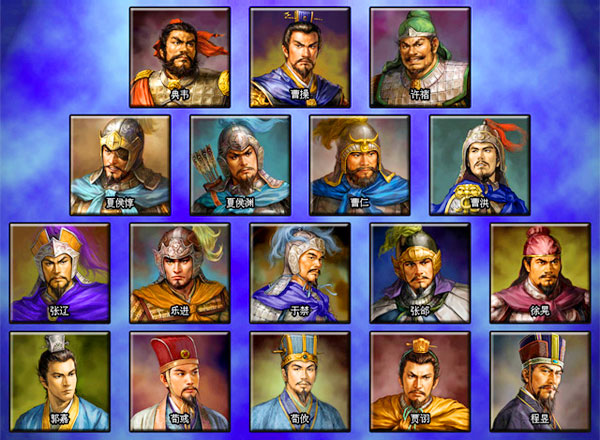 |
Kingdom of Wei |
 |
Kingdom of Shu |
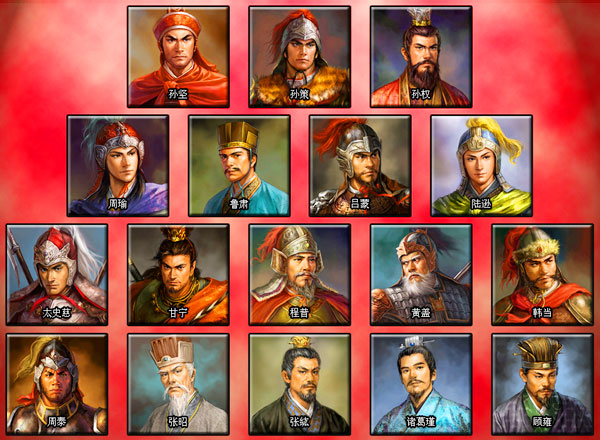 |
Kingdom of Wu |
THREE KINGDOMS
The Three Kingdoms (AD 220–280) were Wei (魏), Shu (蜀), and Wu (吳). The Three Kingdoms period, part of the Six Dynasties period, followed the loss of de facto power of the Han Dynasty emperors. In a strict academic sense, it refers to the period between the foundation of the state of Wei in 220 AD and the conquest of the state of Wu by the Jin Dynasty in 280.
To further distinguish the three states from other historical Chinese states of the same name, historians have added a relevant character: Wei is also known as Cao Wei (曹魏), Shu is also known as Shu Han (蜀漢), and Wu is also known as Eastern Wu (東吳). The term "Three Kingdoms" itself is something of a mistranslation, since each state was eventually headed not by a king, but by an emperor who claimed legitimate succession from the Han Dynasty. Nevertheless, the term "Three Kingdoms" has become standard among sinologists.
The earlier, "unofficial" part of the period, from 184 to 220, was marked by chaotic infighting between warlords in various parts of China. The middle part of the period, from 220 and 263, was marked by a more militarily stable arrangement between three rival states, Wei, Shu, and Wu. The later part of this period was marked by the collapse of the tripartite situation: first the conquest of Shu by Wei (263), then the overthrow of Wei by the Jin Dynasty (265), and the destruction of Wu by Jin (280).
Although relatively short, this historical period has been greatly romanticised in the cultures of China, Japan, Korea, and Vietnam. It has been celebrated and popularised in operas, folk stories, novels and in more recent times, films, television, and video games. The best known of these is Luo Guanzhong's Romance of the Three Kingdoms, a Ming Dynasty historical novel based on events in the Three Kingdoms period. The authoritative historical record of the era is Chen Shou's Records of the Three Kingdoms, along with Pei Songzhi's later annotations of the text.
The Three Kingdoms period was one of the bloodiest in Chinese history. A population census during the late Eastern Han Dynasty reported a population of approximately 50 million, while a population census during the early Western Jin Dynasty reported a population of approximately 16 million.
Technology advanced significantly during this period. Shu chancellor Zhuge Liang invented the wooden ox, suggested to be an early form of the wheelbarrow, and improved on the repeating crossbow. Wei mechanical engineer Ma Jun is considered by many to be the equal of his predecessor Zhang Heng. He invented a hydraulic-powered, mechanical puppet theatre designed for Emperor Ming of Wei, square-pallet chain pumps for irrigation of gardens in Luoyang, and the ingenious design of the South Pointing Chariot, a non-magnetic directional compass operated by differential gears.
1. History
 |
Zhang Jiao |
1.1. Yellow Turban RebellionThe power of the Eastern Han Dynasty went into depression and steadily declined after the reign of Emperor He from a variety of political and economic problems. A series of Han emperors ascended the throne while still youths, and de facto imperial power often rested with the emperors' older relatives. As these relatives occasionally were loath to give up their influence, emperors would, upon reaching maturity, be forced to rely on political alliances with senior officials and eunuchs to achieve control of the government. Political posturing and infighting between imperial relatives and eunuch officials was a constant problem in Chinese government at the time. During the reigns of Emperor Huan and Emperor Ling, leading officials' dissatisfaction with the eunuchs' usurpations of power reached a peak, and many began to openly protest against them. The first and second protests met with failure, and the court eunuchs persuaded the emperor to execute many of the protesting scholars. Some local rulers seized the opportunity to exert despotic control over their lands and citizens, since many feared to speak out in the oppressive political climate. Emperors Huan and Ling's reigns were recorded as particularly dark periods of Han Dynasty rule. In addition to political oppression and mismanagement, China experienced a number of natural disasters during this period, and local rebellions sprung up throughout the country.
In the third month of 184, Zhang Jiao, leader of the Way of Supreme Peace, a Taoist movement, along with his two brothers Zhang Liang and Zhang Bao, led the movement's followers in a rebellion against the government that was called the Yellow Turban Rebellion. Their movement quickly attracted followers and soon numbered several hundred thousands and received support from many parts of China. They had 36 bases throughout China, with large bases having 10,000 or more followers and minor bases having 6,000 to 7,000, similar to Han armies. Their motto was:
"The firmament has perished, the Yellow Sky will soon rise; in this year of jiazi, let there be prosperity in the world!"
 |
Dong Zhuo |
1.2. Dong Zhuo in powerIn the same year, Emperor Ling died, and another struggle began between the court eunuchs for control of the imperial family. Court eunuch Jian Shuo planned to kill General-in-Chief He Jin, a relative of the imperial family, and to replace the crown prince Liu Bian with his younger brother Liu Xie, the Prince of Chenliu (in present-day Kaifeng), though his plan was unsuccessful. Liu Bian took the Han throne as Emperor Shao, and He Jin plotted with warlord Yuan Shao to assassinate the Ten Attendants, a clique of ten eunuchs led by Zhang Rang who controlled much of the imperial court. He Jin also ordered Dong Zhuo, the frontier general in Liang Province, and Ding Yuan, Inspector of Bing Province, to bring troops to the capital to reinforce his position of authority. The eunuchs learned of He Jin's plot, and had him assassinated before Dong Zhuo reached the capital Luoyang. When Yuan Shao's troops reached Luoyang, they stormed the palace complex, killing the Ten Attendants and 2,000 of the eunuchs' supporters. Though this move effectively ended the century-long feud between the eunuchs and the imperial family, it ushered in the era of warlords and martial law that became the Three Kingdoms era.
This event prompted the invitation of Dong Zhuo to enter Luoyang from the northwest boundary of China. At the time China faced the Qiang tribes in the northwest, and thus Dong Zhuo controlled a large army with elite training. When he brought the army to Luoyang, he was able to easily overpower the existing armies of both sides and took control of the imperial court, ushering in a period of civil war across China.
Dong Zhuo then manipulated the succession so that Liu Xie could take the throne in lieu of Liu Bian. Dong Zhuo, while ambitious, genuinely wished for a more capable emperor. On his way to Luoyang, he encountered a small band of soldiers protecting Liu Bian and Liu Xie fleeing the war zone. In the encounter Dong Zhuo acted arrogantly and threateningly, causing Liu Bian to be paralyzed with fear; Liu Xie, the future Emperor Xian, responded calmly with authority and commanded Dong Zhuo to protect the royal family with his army to return to the imperial court.
While Dong Zhuo originally wanted to re-establish the authority of the Han Dynasty and manage all the political conflict properly, his political capability proved to be much worse than his military leadership. His behaviour grew more and more violent and authoritarian, executing or sending into exile all that opposed him, and showed less and less respect to the emperor. He ignored all royal etiquette and frequently carried open weapons into the imperial court. In 190 a coalition led by Yuan Shao was formed between nearly all the provincial authorities in the eastern provinces of the empire against Dong Zhuo. The mounting pressure from repeated defeat on the southern frontline against Sun Jian's forces drove Emperor Xian and later Dong Zhuo himself west to Chang'an in May 191.
Dong Zhuo once again demonstrated his political shortcomings by forcing millions of residents of Luoyang to migrate to Chang'an. He then set fire to Luoyang, preventing occupation by his enemies and destroying the biggest city in China at that time. In addition, he ordered his army to slaughter a whole village of civilians. The soldiers beheaded the civilians and carried their heads into Chang'an to show off as war trophies, pretending to have had a great victory against his enemies. A year later Dong Zhuo was killed in a coup d'etat by Wang Yun and Lu Bu.
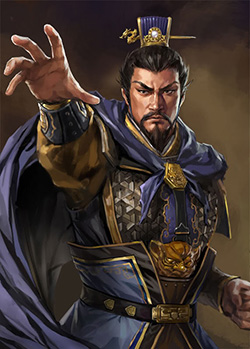 |
Cao Cao |
1.3. Rise of Cao CaoIn 192, there was some talk among the coalition of appointing Liu Yu, an imperial relative, as emperor, and gradually its members began to fall out. Most of the warlords in the coalition, with a few exceptions, sought the increase of personal military power in the time of instability instead of seriously wishing to restore the Han Dynasty's authority. The Han empire was divided between a number of regional warlords. Yuan Shao occupied the northern area of Ye and extended his power, by taking over his superior Han Fu with trickery and intimidation, north of the Yellow River against Gongsun Zan, who held the northern frontier. Cao Cao, directly to Yuan Shao's south, was engaged in a struggle against Yuan Shu and Liu Biao, who occupied respectively the Huai River basin and middle Yangtze regions. Further south the young warlord Sun Ce, taking over after the untimely death of Sun Jian, was establishing his rule in the lower Yangtze, albeit as a subordinate of Yuan Shu. In the west, Liu Zhang held Yi Province while Hanzhong and the northwest were controlled by a motley collection of smaller warlords such as Ma Teng of Liang Province, the original post of Dong Zhuo.
Dong Zhuo, confident in his success, was slain by his follower Lu Bu, who plotted with minister Wang Yun as a result of Wang Yun tricking the both of them into favor of his adopted daughter, Diao Chan. Lü Bu, in turn, was attacked by Dong Zhuo's subordinates: Li Jue, Guo Si, Zhang Ji and Fan Chou. Wang Yun and his whole family were executed. Lü Bu fled to Zhang Yang, a northern warlord, and remained with him for a time before briefly joining Yuan Shao, but it was clear that Lü Bu was far too independent to serve another.
In August 195, Emperor Xian fled the tyranny of Li Jue at Chang'an and made a year long hazardous journey east in search of supporters. By 196, when he was received by Cao Cao, most of the smaller contenders for power had either been absorbed by larger ones or destroyed. This was an extremely important move for Cao Cao following the suggestion from his primary advisor, Xun Yu, commenting that by supporting the authentic emperor, Cao Cao would have the formal legal authority to control the other warlords and force them to comply in order to restore the Han Dynasty.
Cao Cao, whose zone of control was the precursor to the state of Cao Wei, had raised an army in the winter of 189. In several strategic movements and battles, he controlled Yan Province and defeated several factions of the Yellow Turban rebels. This earned him the aid of other local militaries controlled by Zhang Miao and Chen Gong, who joined his cause to create his first sizable army. He continued the effort and absorbed approximately 300,000 Yellow Turban rebels into his army as well as a number of clan-based military groups from the eastern side of Qing Province. In 196 he established an imperial court at Xuchang and developed military agricultural colonies (tuntian) to support his army. Although the system imposed a heavy tax on hired civilian farmers (40% to 60% of agricultural production), the farmers were more than pleased to be able to work with relative stability and professional military protection in a time of chaos. This was later said to be his second important policy for success.
In 194, Cao Cao went to war with Tao Qian of Xu Province, because Tao's subordinate Zhang Kai had murdered Cao Cao's father Cao Song. Tao Qian received the support of Liu Bei and Gongsun Zan, but even then it seemed as if Cao Cao's superior forces would overrun Xu Province entirely. However, Cao Cao received word that Lü Bu had seized Yan Province in his absence, and accordingly he retreated, putting a halt to hostilities with Tao Qian for the time being. Tao Qian died in the same year, leaving his province to Liu Bei. A year later, in 195, Cao Cao managed to drive Lü Bu out of Yan Province. Lü Bu fled to Xu Province and was received by Liu Bei, and an uneasy alliance began between the two.
In the south, Sun Ce, then an independent general under the service of Yuan Shu, defeated the warlords of Yang Province, including Liu Yao, Wang Lang, and Yan Baihu. In 197, Yuan Shu, who was at odds with Cao Cao, Yuan Shao, and Liu Bei, felt assured of victory with his subordinate's conquests, and thus declared himself emperor of the Cheng Dynasty. The move, however, was a strategic blunder, as it drew the ire of many warlords across the land, including Yuan Shu's own subordinate Sun Ce, who had advised Yuan Shu not to make such a move. Cao Cao issued orders to Sun Ce to attack Yuan Shu. Sun Ce complied, but first convinced Cao Cao to form a coalition against Yuan Shu, of which Liu Bei and Lü Bu were members. Attacked on all sides, Yuan Shu was defeated and fled into hiding.
Afterwards, Lü Bu betrayed Liu Bei and seized Xu Province, forming an alliance with Yuan Shu's remnant forces. Liu Bei, together with his followers Zhang Fei and Guan Yu, fled to Cao Cao, who accepted him. Soon, preparations were made for an attack on Lü Bu, and the combined forces of Cao Cao and Liu Bei invaded Xu Province. Lü Bu's men deserted him, Yuan Shu's forces never arrived as reinforcements, and he was bound by his own subordinates Song Xian and Wei Xu and executed on Cao Cao's order.
In 200, Dong Cheng, an imperial relative, received a secret edict from Emperor Xian to assassinate Cao Cao. He collaborated with Liu Bei on this effort, but Cao Cao soon found out about the plot and had Dong Cheng and his conspirators executed, with only Liu Bei surviving and fleeing to join Yuan Shao in the north.
After settling the nearby provinces, including a rebellion led by former Yellow Turbans, and internal affairs with the court, Cao Cao turned his attention north to Yuan Shao, who himself had eliminated his northern rival Gongsun Zan that same year. Yuan Shao, himself of higher nobility than Cao Cao, amassed a large army and camped along the northern bank of the Yellow River.
In 200, after winning a decisive battle against Liu Biao at Sha County and putting down the rebellions of Xu Gong and others, Sun Ce was struck by an arrow and fatally wounded. On his deathbed, he named his younger brother, Sun Quan, as his heir.
Following months of planning, Cao Cao and Yuan Shao clashed at the Battle of Guandu. Overcoming Yuan Shao's superior numbers, Cao Cao decisively defeated him by setting fire to his supplies, and in doing so crippled the northern army. Liu Bei fled to join Liu Biao in Jing Province, and many of Yuan Shao's forces were destroyed. In 202, Cao Cao took advantage of Yuan Shao's death and the resulting division among his sons to advance north of the Yellow River. He captured Ye in 204 and occupied the provinces of Ji, Bing, Qing and You. By the end of 207, after a lightning campaign against the Wuhuan barbarians, Cao Cao had achieved undisputed dominance of the North China Plain.

|
Sun Quan, Liu Bei, Cao Cao, Guan Yu, Zhang Fei,
Zhuge Liang and battle of Red Cliff
|
1.4. Battle of Red CliffsIn 208, Cao Cao marched south with his army hoping to quickly unify the empire. Liu Biao's son Liu Cong surrendered Jing Province and Cao was able to capture a sizable fleet at Jiangling. Sun Quan, the successor to Sun Ce in the lower Yangtze, continued to resist, however. His advisor Lu Su secured an alliance with Liu Bei, himself a recent refugee from the north, and Zhou Yu was placed in command of Sun Quan's navy, along with a veteran general who served the Sun family, Cheng Pu. Their combined armies of 50,000 met Cao Cao's fleet and 200,000-strong force at Red Cliffs that winter. After an initial skirmish, an attack beginning with a plan to set fire to Cao Cao's fleet was set in motion to lead to the decisive defeat of Cao Cao, forcing him to retreat in disarray back to the north. The allied victory at Red Cliffs ensured the survival of Liu Bei and Sun Quan, and provided the basis for the states of Shu and Wu.
After his return to the north, Cao Cao contented himself with absorbing the northwestern regions in 211 and consolidating his power. He progressively increased his titles and power, eventually becoming the King of Wei in 217, a title bestowed upon him by the puppet Emperor Xian that he controlled. Liu Bei, having defeated the weak Jing Province warlords Han Xuan, Jin Xuan, Zhao Fan, and Liu Du, entered Yi Province and later in 214 displaced Liu Zhang as ruler, leaving Guan Yu in charge of Jing Province. Sun Quan, who had in the intervening years being engaged with defenses against Cao Cao in the southeast at Hefei, now turned his attention to Jing Province and the middle Yangtze. Tensions between the allies were increasingly visible. In 219, after Liu Bei successfully seized Hanzhong from Cao Cao and as Guan Yu was engaged in the siege of Fancheng, Sun Quan's general Lü Meng seized Jing Province in a surprise invasion. Guan Yu was captured and executed on Sun Quan's order.
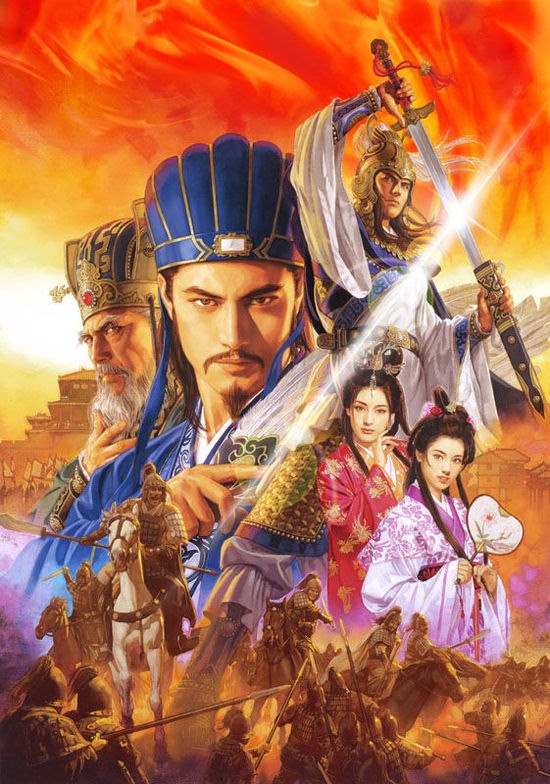
|
Sima Yi, Zhuge Liang, Zhao Yun, Lady Mi, Lady Gan |
1.5. Emergence of the Three KingdomsIn the first month of 220, Cao Cao died and in the tenth month his son Cao Pi forced Emperor Xian to abdicate, thus ending the Han Dynasty. He named his state Wei and proclaimed himself emperor in Luoyang. In 221, Liu Bei declared himself emperor, in a bid to restore the fallen Han Dynasty. (His state is known in history as "Shu" or "Shu Han") In the same year, Wei bestowed on Sun Quan the title of King of Wu. A year later, Shu declared war on Wu (this was because Wu had allied with Wei in order to defeat the sworn brother of Liu Bei - Guan Yu - who at that time placed in charge on Jing Province, as it was most strategic location in all of the three kingdoms) and met the Wu armies at the Battle of Xiaoting (also known as Battle of Yiling). At Xiaoting, Liu Bei was disastrously defeated by Sun Quan's commander Lu Xun and forced to retreat back to Shu, where he died soon afterward. After the death of Liu Bei, Shu and Wu resumed friendly relations at the expense of Wei, thus stabilizing the tripartite configuration. In 222, Sun Quan renounced his recognition of Cao Pi's regime and, in 229, he declared himself emperor of Eastern Wu in Wuchang.
Dominion of the north completely belonged to Wei, whilst Shu occupied the southwest and Wu the central south and east. The external borders of the states were generally limited to the extent of Chinese civilization. For example, the political control of Shu on its southern frontier was limited by the tribes of present-day Yunnan and Burma, known collectively as the "Nanman" (southern barbarians).
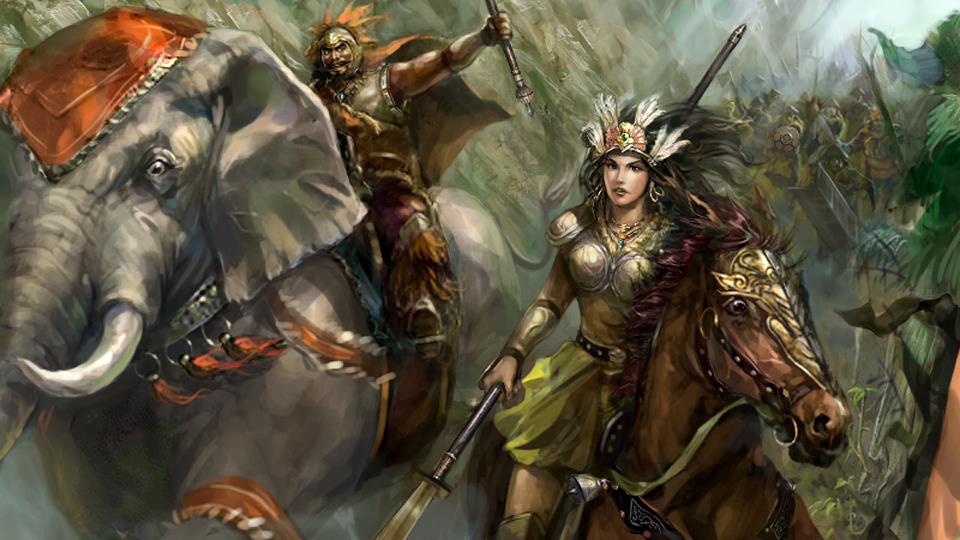
|
Meng Huo and his wife Zhurong |
1.6. ConsolidationIn 223, Liu Shan rose to the throne of Shu following his father's defeat and death. The defeat of Liu Bei at Xiaoting ended the period of hostility between Wu and Shu and both used the opportunity to concentrate on internal problems and the external enemy of Wei. For Sun Quan, the victory terminated his fears of Shu expansion into Jing Province and he turned to the aborigines of the southeast, whom the Chinese collectively called the "Shanyue". A collection of successes against the rebellious tribesmen culminated in the victory of 224. In that year Zhuge Ke ended a three-year siege of Danyang with the surrender of 100,000 Shanyue. Of these, 40,000 were drafted as auxiliaries into the Wu army. Meanwhile Shu was also experiencing troubles with the indigenous tribes of their south. The southwestern Nanman peoples rose in revolt against Shu authority, captured and looted cities in Yi Province. Zhuge Liang, recognising the importance of stability in the south, ordered the advance of the Shu armies in three columns against the Nanman. He fought a number of engagements against the chieftain Meng Huo, at the end of which Meng Huo submitted. A tribesman was allowed to reside at the Shu capital Chengdu as an official and the Nanman formed their own battalions within the Shu army.
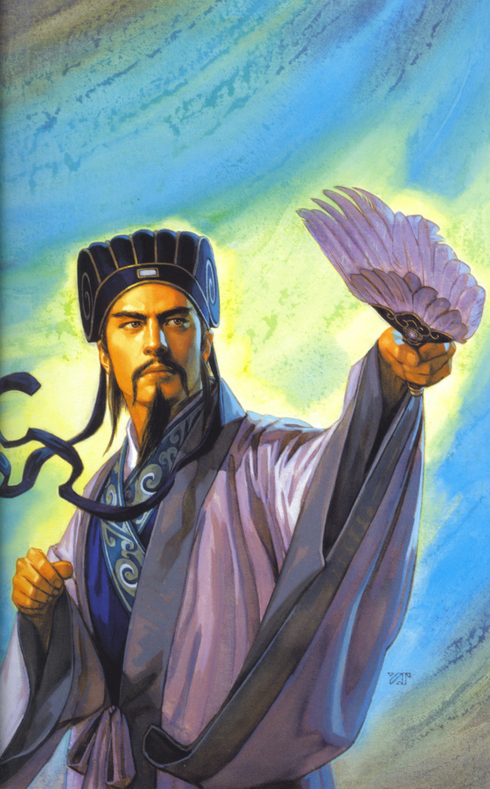
|
Zhuge Liang |
1.7. Zhuge Liang's Northern ExpeditionsAt the end of Zhuge Liang's Southern Campaign, the Wu-Shu alliance came to fruition and Shu was free to move against the north. In 227, Zhuge Liang transferred his main Shu armies to Hanzhong, and opened up the battle for the northwest with Wei. The next year, he ordered Zhao Yun to attack from Ji Gorge as a diversion while Zhuge himself led the main force to Mount Qi. The vanguard Ma Su, however, suffered a tactical defeat at Jieting and the Shu army was forced to withdraw. In the next six years Zhuge Liang attempted several more offensives, but supply problems limited the capacity for success. In 234 he led his last great northern offensive, reaching the Battle of Wuzhang Plains south of the Wei River. Due to the death of Zhuge Liang (234), however, the Shu army was forced once again to withdraw, but were pursued by Wei. The Shu forces began to withdraw; Sima Yi deduced Zhuge Liang's demise and ordered an attack. Shu struck back almost immediately, causing Sima Yi to second guess and allow Shu to withdraw successfully.
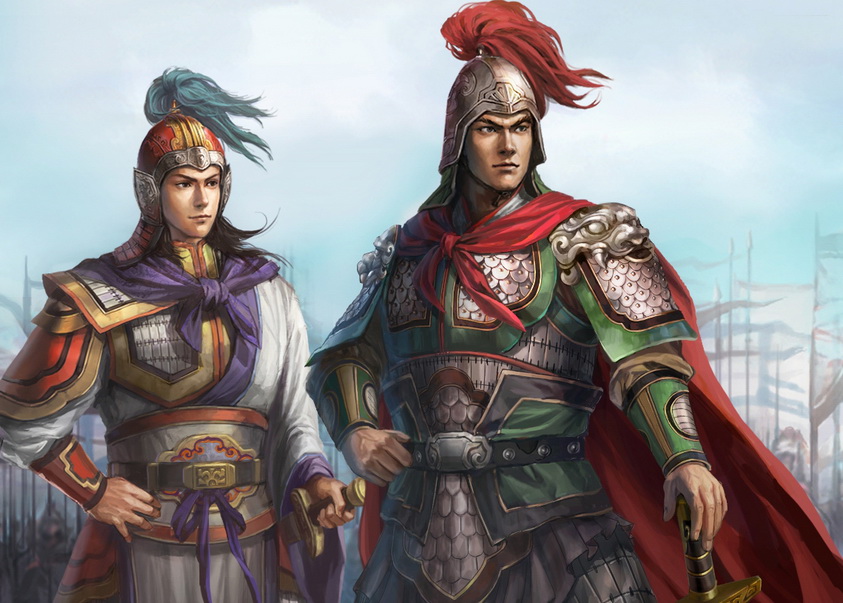
|
Zhou Yu and Sun Ce |
1.8. Wu and the SouthIn the times of Zhuge Liang's northern offensives, the state of Wu had always been on the defensive against invasions from the north. The area around Hefei was the scene of many bitter battles and under constant pressure from Wei after the Battle of Red Cliffs. Warfare had grown so intense that many of the residents chose to migrate and resettle south of the Yangtze River. After Zhuge Liang's death, attacks on the southern Huai River region intensified but nonetheless, Wei could not break through the line of the river defenses erected by Wu, which included the Ruxu fortress.
Sun Quan's long reign is regarded as a time of plenty for his southern state. Migrations from the north and the settlement of the Shanyue increased manpower for agriculture, especially along the lower reaches of the Yangtze and in Kuaiji commandery (present-day Shaoxing). River transport blossomed, with the construction of the Zhedong and Jiangnan canals. Trade with Shu flourished, with a huge influx of Shu cotton and the development of celadon and metal industries. Ocean transport was improved to such an extent that sea journeys were made to Manchuria and the island of Taiwan. In the south, Wu merchants reached Linyi (Southern Vietnam) and Funan Kingdom. As the economy prospered, so too did the arts and culture. In the Yangtze delta, the first Buddhist influences reached the south from Luoyang.

|
Jiang Wan, Zhuge Liang, Wei Yan, Zhao Yun |
2. Decline and end of the Three Kingdoms
From the late 230s, tensions began to become visible between the imperial Cao clan and the Sima clan. Following the death of Cao Zhen, factionalism was evident between Cao Shuang and the Grand Tutor Sima Yi. In deliberations, Cao Shuang placed his own supporters in important posts and excluded Sima Yi, whom he regarded as a dangerous threat. The power of the Sima clan, one of the great landowning families of the Han Dynasty, was bolstered by Sima Yi's military victories. Additionally, Sima Yi was an extremely capable strategist and politician. In 238 he crushed the rebellion of Gongsun Yuan and brought the Liaodong region directly under central control. Ultimately, he outmaneuvered Cao Shuang in power play. Taking advantage of an excursion by the imperial clansmen to the Gaoping Tombs, Sima Yi undertook a putsch in Luoyang, forcing Cao Shuang's faction from authority. Many protested against the overwhelming power of the Sima family; notable among these were the Seven Sages of the Bamboo Grove. One of the sages, Xi Kang, was executed as part of the purges after Cao Shuang's downfall.
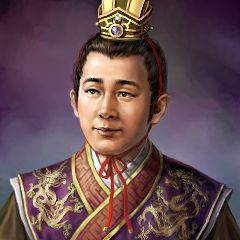
|
Liu Shan |
2.1. Fall of Shu
The decreasing strength of the Cao clan was mirrored by the decline of Shu. After Zhuge Liang's death, his position as chancellor fell to Jiang Wan, Fei Yi and Dong Yun, in that order. But after 258, Shu politics became increasingly controlled by the eunuch faction and corruption rose. Despite the energetic efforts of Jiang Wei, Zhuge Liang's protege, Shu was unable to secure any decisive achievement. In 263, Wei launched a three-pronged attack and the Shu army was forced into general retreat from Hanzhong. Jiang Wei hurriedly held a position at Jiange but he was outflanked by the Wei commander Deng Ai, who force-marched his army from Yinping through territory formerly considered impassable. By the winter of the year, the capital Chengdu fell due to the strategic invasion of Wei by Deng Ai who invaded Chengdu personally. The emperor Liu Shan thus surrendered. The state of Shu had come to an end after 43 years. Liu Shan was reinstated to the Wei capital of Luoyang and was given the new title of the "Duke of Anle". Directly translated, it meant the "Duke of Safety and Happiness" and was a trivial position with no actual power.
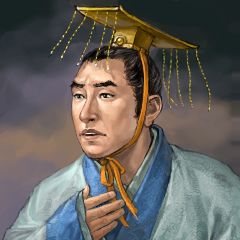
|
Cao Huan |
2.2. Fall of Wei
Cao Huan succeeded to the throne in 260 after Cao Mao was killed in a failed coup against Sima Zhao. Soon after, Sima Zhao died and his title as Duke of Jìn was inherited by his son Sima Yan. Sima Yan immediately began plotting to become emperor but faced stiff opposition. However, due to advice from his advisors, Cao Huan decided the best course of action would be to abdicate, unlike his predecessor Cao Mao. Sima Yan seized the throne in 264 after forcing Cao Huan's abdication, effectively overthrowing the Wei Dynasty and establishing the successor Jìn Dynasty. This situation was similar to the deposal of Emperor Xian of Han by Cao Pi 40 years earlier.
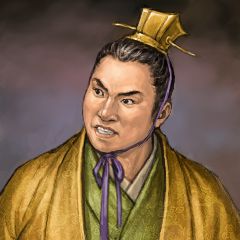
|
Sun Hao |
2.3. Fall of Wu
Following Sun Quan's death and the ascension of the young Sun Liang to the throne in 252, the state of Wu went into a period of steady decline. Successful Wei suppression of rebellions in the southern Huai River region by Sima Zhao and Sima Shi reduced any opportunity of Wu influence. The fall of Shu signalled a change in Wei politics. After Liu Shan surrendered to Wei, Sima Yan (grandson of Sima Yi), overthrew the Wei emperor and proclaimed his own dynasty of Jin in 264, ending 46 years of Cao dominion in the north. After Jin's rise, emperor Sun Xiu of Wu died, and his ministers gave the throne to Sun Hao. Sun Hao was a promising young man, but upon ascension he became a tyrant, killing or exiling all who dared oppose him in the court. In 269 Yang Hu, a Jin commander in the south, started preparing for the invasion of Wu by ordering the construction of a fleet and the training of marines in Sichuan under Wang Jun. Four years later, Lu Kang, the last great general of Wu, died leaving no competent successor. The planned Jin offensive finally came in the winter of 279. Sima Yan launched five simultaneous offensives along the Yangtze River from Jianye (present-day Nanjing) to Jiangling whilst the Sichuan fleet sailed downriver to Jing Province. Under the strain of such an enormous attack, the Wu forces collapsed and Jianye fell in the third month of 280. Sun Hao surrendered and was given a fiefdom on which to live out his days. This marked the end of the Three Kingdoms era, and the beginning of a break in the forthcoming 300 years of chaos.

|
Liu Bei, Cao Cao, Sun Quan, Diao Chan, Lu Bu, Guan Yu, Zhang Fei |
3. PopulationAfter the Yellow Turban Rebellion, serious famine followed in the Central Plains of China. After his coming to power, Dong Zhuo gave full swing to his army to plunder and rape women. When the Guandong Coalition was starting the campaign against Dong Zhuo, he embarked upon a scorched earth campaign, proclaiming that "all the population of Luoyang be forced to move to Chang'an, all the palaces, temples, official residences and homes be burnt, no one should stay within that area of 200 li". Considering the hardships of that time this amounted to a death sentence for many, and cries of discontent rose as the population of Luoyang decreased sharply. When Cao Cao attacked Xu Province, it was said that "hundreds of thousands of men and women were buried alive, even dogs and chickens did not survive. The Si River was blocked. From then on, these five towns never recover." When Li Jue and his army were advancing towards the Guanzhong area, "there remained hundreds of thousands of people, but Li Jue allowed his army to plunder the cities and the people, thus making the people have nothing but eat each other to death."
It can be known from the following table that how serious the decrease of population was during that period. From the late Eastern Han to the Western Jin Dynasty, despite its length about 125 years, the peak number of population only equaled 35.3% of the peak number of the entire Eastern Han Dynasty. From then on to Sui Dynasty, the population never recovered. It also should be noted that the high militarization of the population was common. For example, the population of Shu was 900,000, but the military were more than 100,000, occupying more than 10% of the population. The Records of the Three Kingdoms contains population figures for the Three Kingdoms. As with many Chinese historical population figures, these numbers are likely to be less than the actual populations, since census and tax records went hand in hand, and tax evaders were often not on records.
While it is clear that warfare undoubtedly took many lives during this period, the census figures do not support the idea that millions were wiped out solely from warfare. Other factors such as mass migration out of China must be taken into account.

|
Zhao Yun, Liu Shan, Lu Bu |
4. Economy
In the late Eastern Han Dynasty, due to natural disasters and social unrest, the economy was badly depressed, leading to the massive waste of farmland. Some local landlords and aristocracy established their own strongholds to defend themselves and developed agriculture, which gradually evolved into a self-sufficient manorial system. The system of strongholds and manors also had effects on the economical mode of following dynasties. In addition, because of the collapse of the imperial court, those worn copper coins were not melted and reminted and many privately minted coins appeared. In the Three Kingdoms period, newly minted coins never made their way into currency. Due to the collapse of the coinage, Cao Wei officially declared silk cloth and grains as the main currencies in 221.
In economic terms the division of the Three Kingdoms reflected a reality that long endured. Even during the Northern Song Dynasty, 700 years after the Three Kingdoms period, it was possible to think of China as being composed of three great regional markets. (The status of the northwest was slightly ambivalent, as it had links with the northern region and Sichuan). These geographical divisions are underscored by the fact that the main communication routes between the three main regions were all man-made: the Grand Canal linking north and south, the hauling-way through the Three Gorges of the Yangtze River linking southern China with Sichuan and the gallery roads joining Sichuan with the northwest. The break into three separate entities was quite natural and even anticipated by such political foresight as that of Zhuge Liang.
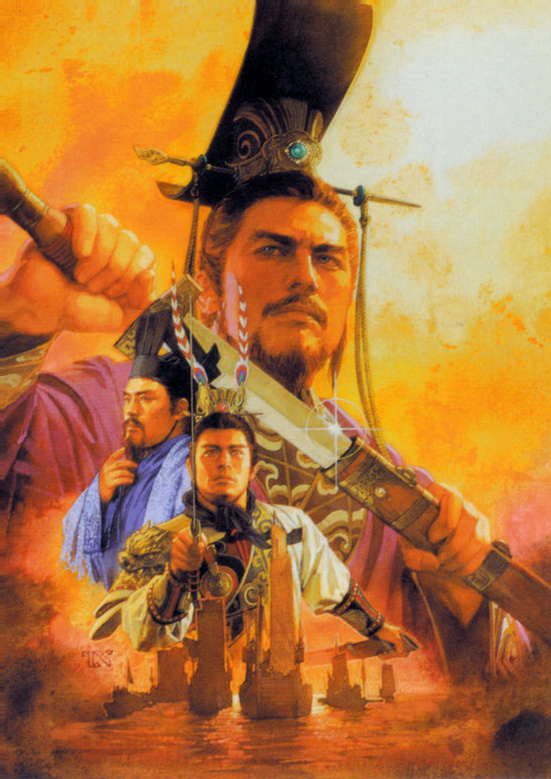
|
Liu Bei, Chen Gong, Lu Bu |
5. Timeline of the Three Kingdoms period
This is a timeline of the Three Kingdoms period (220–280) of Chinese history. In a strict academic sense, the Three Kingdoms period refers to the interval between the founding of the state of Cao Wei (220–265) in 220 and the conquest of the state of Eastern Wu (229–280) by the Western Jin Dynasty (265–316) in 280. However, many Chinese historians and laymen extend the starting point of this period back to the Yellow Turban Rebellion that took place in 184 during the late Eastern Han Dynasty (25–220).
Year | Major events |
184 | Yellow Turban Rebellion |
189 | Emperor Ling of Han dies;
Liu Bian is enthroned as Emperor Shao of Han;
Power struggle between He Jin and the Ten Eunuchs;
Dong Zhuo takes control of the imperial court and deposes Emperor Shao;
Liu Xie is enthroned as Emperor Xian of Han;
Lü Bu kills Ding Yuan and defects to Dong Zhuo |
190 | Dong Zhuo murders the deposed Emperor Shao;
A coalition of warlords and regional officials launch a campaign against Dong Zhuo |
191 | Battle of Jieqiao between Yuan Shao and Gongsun Zan;
Sun Jian is killed in action at the Battle of Xiangyang against Liu Biao |
192 | Lü Bu kills Dong Zhuo |
193 | Cao Cao invades Xu Province;
Battle of Yan Province between Cao Cao and Lü Bu |
194 | Sun Ce's conquests in Jiangdong begin;
Liu Bei succeeds Tao Qian as Governor of Xu Province |
196 | Cao Cao finds Emperor Xian of Han in the ruins of the old capital Luoyang and brings him to Xuchang, where the new capital was established;
Lü Bu seizes control of Xu Province's capital Xiapi from Liu Bei |
197 | Battle of Wancheng between Cao Cao and Zhang Xiu;
Campaign against Yuan Shu begins |
198 | The combined forces of Cao Cao and Liu Bei defeat Lü Bu at the Battle of Xiapi |
199 | Yuan Shao eliminates Gongsun Zan in the Battle of Yijing;
Yuan Shu is defeated and dies in Shouchun;
Liu Bei seizes Xu Province from Cao Cao;
Cao Cao defeats Liu Bei and retakes Xu Province;
Guan Yu surrenders to Cao Cao and temporarily serves the latter |
200 | Sun Ce is assassinated;
Sun Quan succeeds Sun Ce as warlord of Jiangdong;
Battle of Guandu between Cao Cao and Yuan Shao |
202 | Cao Cao's campaigns to reunify northern China begin |
203 | Battle of Xiakou between Sun Quan and Liu Biao |
207 | Northern China is united under Cao Cao's control after the Battle of White Wolf Mountain;
Zhuge Liang presents the Longzhong Plan to Liu Bei and comes to serve the latter |
208 | Battle of Jiangxia between Sun Quan and Liu Biao;
Liu Cong surrenders Jing Province to Cao Cao;
Battle of Red Cliffs between Cao Cao and the combined forces of Liu Bei and Sun Quan |
211 | Battle of Tong Pass between Cao Cao and a coalition force led by Ma Chao and Han Sui;
Cao Cao's campaigns in northwestern China begin |
212 | Liu Bei's takeover of Yi Province begins |
213 | Emperor Xian of Han enfeoffs Cao Cao as "Duke of Wei" and grants him the nine bestowments |
215 | Liu Bei takes complete control of Yi Province from Liu Zhang;
Zhang Lu surrenders Hanzhong to Cao Cao after the Battle of Yangping;
Battle of Xiaoyao Ford between Cao Cao and Sun Quan |
216 | Emperor Xian of Han promotes Cao Cao to "King of Wei" |
217 | Liu Bei launches the Hanzhong Campaign against Cao Cao;
Battle of Ruxu between Cao Cao and Sun Quan |
219 | Liu Bei emerges victorious in the Hanzhong Campaign and declares himself "King of Hanzhong";
Battle of Fancheng between the forces of Cao Cao and Liu Bei;
Lü Meng's invasion of Jing Province;
Guan Yu is captured and executed by Sun Quan |
220 | Cao Cao dies;
Cao Pi forces Emperor Xian of Han to abdicate the throne to him and ends the Han Dynasty;
Cao Pi establishes the state of Wei;
Sun Quan becomes a vassal under Wei;
Start of the Three Kingdoms period |
221 | Liu Bei declares himself emperor and establishes the state of Shu |
222 | Liu Bei is defeated by Sun Quan's forces at the Battle of Xiaoting;
Sun Quan declares independence from Wei and rules as "King of Wu" |
223 | Liu Bei dies;
Liu Shan becomes emperor of Shu;
Shu and Wu reaffirm their alliance;
Battle of Jiangling between Wei and Wu |
225 | Zhuge Liang's Southern Campaign |
226 | Cao Pi dies;
Cao Rui becomes emperor of Wei |
228 | Zhuge Liang's Northern Expeditions begin;
Battle of Jieting between Wei and Shu;
Battle of Shiting between Wei and Wu |
229 | Sun Quan proclaims himself "Emperor of Wu" |
234 | Zhuge Liang dies at the Battle of Wuzhang Plains; |
238 | Sima Yi's Liaodong campaign |
239 | Cao Rui dies;
Cao Fang becomes emperor of Wei |
245 | Goguryeo–Wei War ends |
247 | Jiang Wei's Northern Expeditions begin |
249 | Sima Yi seizes power from Cao Shuang in the Incident at Gaoping Tombs |
251 | Wang Ling Rebellion in Wei |
252 | Sun Quan dies;
Sun Liang becomes emperor of Wu;
Battle of Dongxing between Wei and Wu |
254 | Cao Fang is deposed by Sima Shi;
Cao Mao becomes emperor of Wei |
255 | Guanqiu Jian and Wen Qin Rebellion in Wei;
Battle of Didao between Wei and Shu |
258 | Zhuge Dan Rebellion in Wei is suppressed;
Sun Liang is deposed by the regent Sun Chen;
Sun Xiu becomes emperor of Wu |
260 | Cao Mao is killed in a coup to seize back state power from Sima Zhao;
Cao Huan becomes emperor of Wei |
263 | Conquest of Shu by Wei |
264 | Sun Xiu dies;
Sun Hao becomes emperor of Wu |
265 | Sima Yan forces Cao Huan to abdicate the throne to him and ends the state of Wei;
Sima Yan founds the Jin Dynasty |
280 | Conquest of Wu by Jin;
End of the Three Kingdoms period |